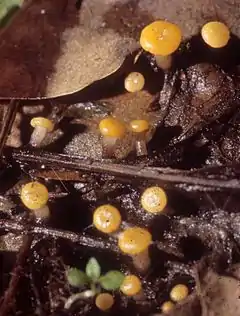Vibrisseaceae
The Vibrisseaceae are a family of fungi in the order Helotiales. The family was circumscribed by mycologist Richard Korf in 1990 to include the genera Vibrissea, Chlorovibrissea, and Leucovibrissea.[2][3] According to the Dictionary of the Fungi (10th edition, 2008), the family encompasses 5 genera and 59 species.[4]
| Vibrisseaceae | |
|---|---|
 | |
| Vibrissea truncorum | |
| Scientific classification | |
| Domain: | Eukaryota |
| Kingdom: | Fungi |
| Division: | Ascomycota |
| Class: | Leotiomycetes |
| Order: | Helotiales |
| Family: | Vibrisseaceae Korf (1990) |
| Type genus | |
| Vibrissea Fr. (1822) | |
| Genera[1] | |
| |
Description
Members of the Vibrisseaceae have filiform (threadlike) to cylindrical ascospores.[3]
References
- "Vibrisseaceae". Global Biodiversity Information Facility. Retrieved 20 April 2021.
- Korf RP. (1990). "Discomycete systematics today: a look at some unanswered questions in a group of unitunicate ascomycetes". Mycosystema. 3: 19–27.
- Iturriaga T. (1995). "A preliminary discomycete flora of Macaronesia: Part 9. Vibrisseaceae". Mycotaxon. 54: 1–17.
- Kirk PM, Cannon PF, Minter DW, Stalpers JA (2008). Dictionary of the Fungi (10th ed.). Wallingford, UK: CABI. p. 725. ISBN 978-0-85199-826-8.
This article is issued from Wikipedia. The text is licensed under Creative Commons - Attribution - Sharealike. Additional terms may apply for the media files.